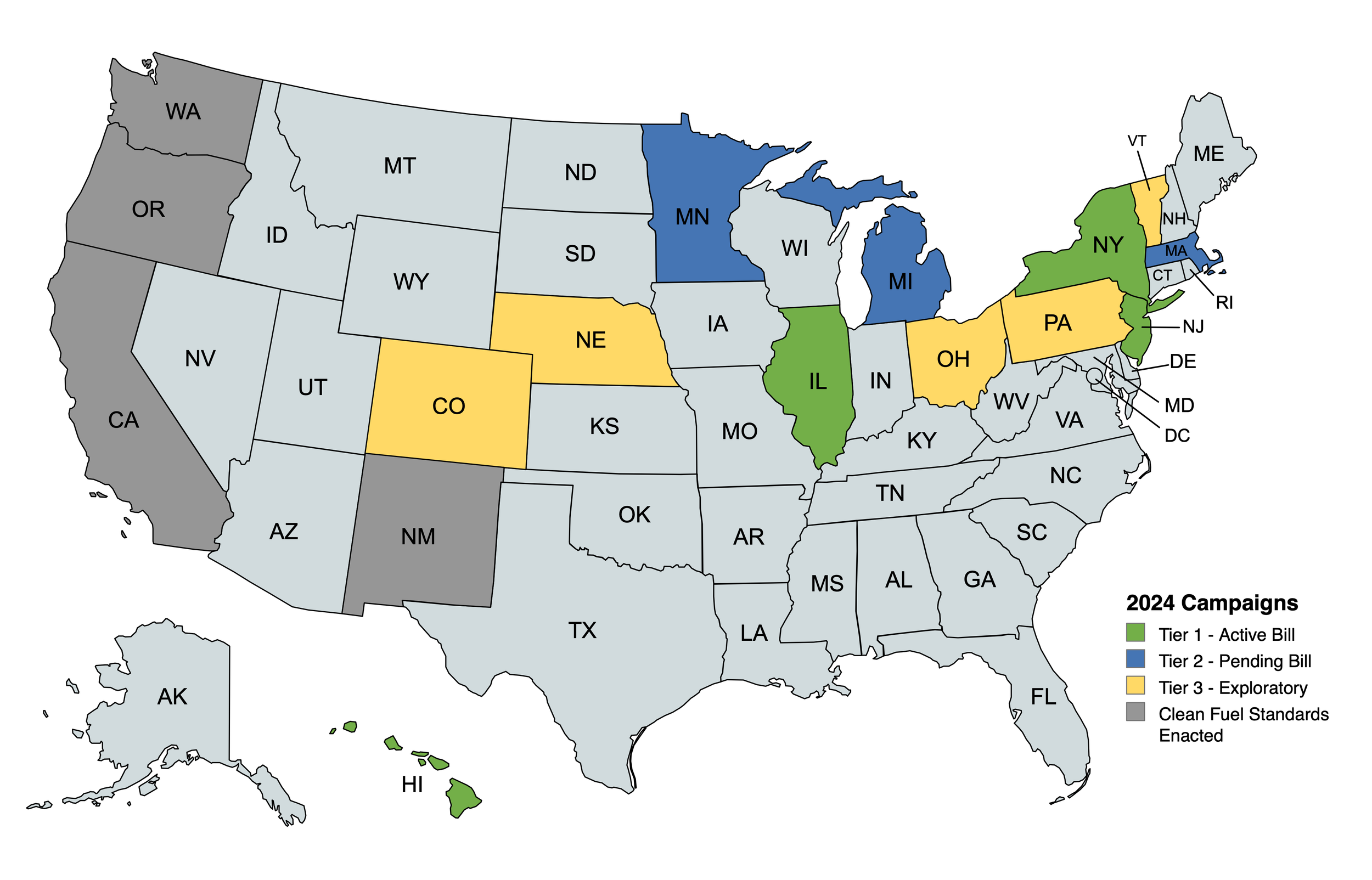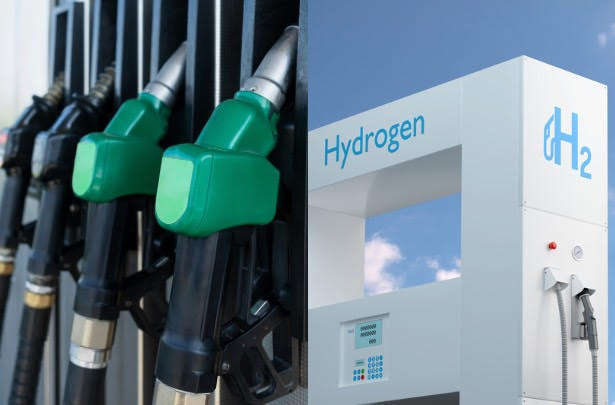As companies look for ways to reduce carbon emissions, green hydrogen—made by splitting water using renewable energy—has become an important solution, especially in transportation, the sector responsible for about one-third of all carbon emissions in the U.S.
To help move away from fossil fuels, many states have created programs to encourage cleaner fuels. California’s Low Carbon Fuel Standard (LCFS) is one of the first and better-known programs. Other states, like Washington and Oregon, have similar initiatives, such as the Clean Fuel Standard (CFS) and Clean Fuel Program (CFP). While the names may vary, the goal is the same: to reduce carbon emissions by setting annual carbon intensity (CI) targets for regulated fuels, such as gasoline and diesel. Carbon intensity refers to how much carbon dioxide is emitted per unit of energy produced. Over time, these CI targets become more stringent, pushing industries toward cleaner alternatives like green hydrogen.
One question we often get asked is, “How does green hydrogen fit into state low-carbon fuel standard programs?” We’ll explain below.
How Low-Carbon Fuel Standards Work: Understanding Credits and Deficits
States with low-carbon fuel standards identify parties responsible for owning or producing transportation fuels as Regulated Parties—RPs. These typically include petroleum importers, refiners, and wholesalers. States will then create a market where credits can be generated by RPs that produce low-CI fuels, while RPs responsible for high-CI fuels must purchase and retire credits to offset their emissions. It’s important to note that LCFS programs don’t just provide incentives for companies that produce cleaner fuels but also create financial disincentives for companies that use high-carbon fuels like diesel or gasoline.
To determine what credits should be allotted, states will first try to match the project to existing pathways where the particular CI amount has already been estimated. For clean hydrogen, this might include pathways for hydrogen made using solar or grid-powered electrolysis. If a project uses new methods not already approved, it can apply for a custom pathway, often called Tier 2 or project-based crediting. To help new ideas get started quickly, some states offer temporary approvals. For example, in Oregon, a project can get a specific CI score after just 90 days of running. This allows new technologies to earn credits sooner, encouraging innovation in low-carbon fuel production.
Incorporating Green Hydrogen into LCFS Frameworks
For green hydrogen to be included in LCFS frameworks, states must first identify the Regulated Party. In California, the RP for hydrogen is the entity that owns the fueling supply equipment; in Oregon, it’s the entity that owns the finished hydrogen fuel, whereas in Washington, it’s the producer or importer of renewable hydrogen.
In addition to identifying the Regulated Party, the financial value of incorporating green hydrogen into the LCFS framework is another key factor. LCFS credit prices have fluctuated over time, with average prices in 2023 ranging from approximately $60 to $80 per ton of CO2e. [1] This can translate to roughly $1-2/kg of hydrogen, depending on the specific pathway and end-use application. Green hydrogen is gaining increased attention within the LCFS framework as production scales up and costs decrease.
While zero-carbon fuels used in non-transportation applications like steelmaking generally don’t qualify for LCFS credits, hydrogen used in the following scenarios may be eligible under multiple LCFS jurisdictions:
- As a transportation fuel in fuel cell electric vehicles
- In the production of other low-carbon transportation fuels
- In certain off-road applications, such as forklifts or cargo-handling equipment
For example, green electrolytic hydrogen produced at our Antelope Valley Hydrogen 1 facility near Palmdale, Los Angeles County, will qualify for the full $3/kg Hydrogen Production Tax Credit (PTC) under Section 45V of the IRA and will also be eligible for LCFS credits. This assumes hydrogen is used for refining fuels, hydrogen fuel cells, or other transportation applications, depending on the applicable pathways and credit values. Similarly, NovoHydrogen’s Express Ranch Project in Oregon, part of the Pacific Northwest Hydrogen Hub, will support heavy-duty industrial transportation, including mining and trucking, while generating credits through Oregon’s Clean Fuels Program, estimated at ~$120 – $140 per ton of CO2e.
The Future of LCFS Programs Across the U.S.
California launched one of the first LCFS programs nearly 15 years ago and their LCFS policy has been instrumental in advancing alternative fuels. The program continues to evolve, and in early 2024, the California Air Resources Board (CARB), which oversees implementation, postponed a vote on further changes until after the U.S. presidential elections. CARB also enacted California’s Advanced Clean Fleets rule, requiring the state’s 1.8 million commercial trucks to decarbonize over the next 20 years as well as Advanced Clean Trucks and Innovative Clean Transit regulations.
While California is at the forefront, several other states have followed suit. Oregon and Washington have active markets today, as does British Columbia. New Mexico has also just introduced a clean fuel standard, with more states, including Illinois and New York, considering similar policies. As these programs expand, the demand for low-carbon fuels—including green hydrogen—will continue to rise.

Conclusion: Unlocking Opportunities with Green Hydrogen
The expansion of LCFS programs across the U.S. is creating significant opportunities for consumers to benefit from green hydrogen adoption. Paired with federal incentives like the Inflation Reduction Act (IRA), including the Section 45V Production Tax Credit and the Section 48 Investment Tax Credit, making green hydrogen cost competitive with diesel fuel for trucks and buses. As these programs develop, businesses can earn LCFS credits by choosing green hydrogen, helping to offset costs while enhancing operational sustainability and resilience.
If your company is considering a switch to green hydrogen, our team can help assess your eligibility and identify the relevant LCFS pathways for your operations. Please contact us at info@novohydrogen.com to explore potential earnings from LCFS credits and stay updated on any changes that may impact your eligibility.
[1]The average value of a credit ranged from $125 – 199 in 2022. However, due to macroeconomic conditions and a near-term oversupply of renewable diesel/anaerobic digestion, prices have come down a bit as more credits come online. The ongoing California rulemaking is designed to bring pricing back up, in part through a one-time step-down in the carbon intensity threshold for fuels.

